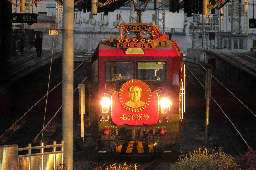Maglev (derived from magnetic levitation), is a system of train transportation that uses two sets of electromagnets: one set to repel and push the train up off the track, and another set to move the elevated train ahead, taking advantage of the lack of friction. Such trains rise approximately 10 centimetres (4 in) off the track. There are both high speed, intercity maglev systems (over 400 kilometres per hour or 250 miles per hour), and low speed, urban maglev systems (80–200 kilometres per hour or 50–124 miles per hour) being built and under construction and development.
With maglev technology, the train travels along a guideway of electromagnets which control the train's stability and speed. While the propulsion and levitation require no moving parts, the bogies can move in relation to the main body of the vehicle and some technologies require support by retractable wheels at low speeds under 150 kilometres per hour (93 mph). This compares with electric multiple units that may have several dozen parts per bogie. Maglev trains can therefore in some cases be quieter and smoother than conventional trains and have the potential for much higher speeds.
Maglev vehicles have set several speed records, and maglev trains can accelerate and decelerate much faster than conventional trains; the only practical limitation is the safety and comfort of the passengers, although wind resistance at very high speeds can cause running costs that are four to five times that of conventional high-speed rail (such as the Tokaido Shinkansen). The power needed for levitation is typically not a large percentage of the overall energy consumption of a high-speed maglev system. Overcoming drag, which makes all open-air land transport more energy intensive at higher speeds, takes the most energy. Vactrain technology has been proposed as a means to overcome this limitation. Maglev systems have been much more expensive to construct than conventional train systems, although the simpler construction of maglev vehicles makes them cheaper to manufacture and maintain.[citation needed]
The Shanghai maglev train, also known as the Shanghai Transrapid, has a top speed of 430 kilometres per hour (270 mph). The line is the fastest operational high-speed maglev train, designed to connect Shanghai Pudong International Airport and the outskirts of central Pudong, Shanghai. It covers a distance of 30.5 kilometres (19 mi) in just over 8 minutes. For the first time, the launch generated wide public interest and media attention, propelling the popularity of the mode of transportation. It is also the only maglev train in the world that can be considered as high speed.
Despite over a century of research and development, there are only six operational maglev trains today — three in China, two in South Korea, and one in Japan. Maglev can be hard to economically justify for certain locations, however it has notable benefits over conventional railway systems, which includes lower operating and maintenance costs (with zero rolling friction its parts do not wear out quickly and hence less need to replace parts often), significantly lower odds of derailment (due to its design), an extremely quiet and smooth ride for passengers, little to no air pollution, and the railcars can be built wider and make it more comfortable and spacious for passengers. And also because it can travel up higher ascending grades (up to 10 percent), compared to conventional trains (up to 4 percent or less), maglev trains can also reduce the need to create new tunnels or to level the landscape to build its tracks.
Megathreads and spaces to hang out:
- ❤️ Come listen to music and Watch movies with your fellow Hexbears nerd, in Cy.tube
- 💖 Come talk in the New Monthly queer thread
- 💛 Read about a current topic in the news
- ⭐️ October Movie Nominations ⭐️
reminders:
- 💚 You nerds can join specific comms to see posts about all sorts of topics
- 💙 Hexbear’s algorithm prioritizes struggle sessions over upbears
- 💜 Sorting by new you nerd
- 🌈 If you ever want to make your own megathread, you can go here nerd
- 🐶 Join the unofficial Hexbear-adjacent Mastodon instance toots.matapacos.dog
Links To Resources (Aid and Theory):
Aid:
- 💙Comprehensive list of resources for those in need of an abortion -- reddit link
- 💙Resources for Palestine
Theory:


it's the second of june and i've already seen people say kink shouldn't be at pride because uhhh aces or something (they definitely consulted ace people and are not just talking for them) yippee
being ace and disabled is the ultimate combo of people using you to advocate against your own interests
i have only ever seen this online (from queer people at least)
it strikes me as a thing that is exclusive to people who's only experience of a queer community is on the internet
also my experience, yea. it's really annoying
I never quite got this, isn't "kink at pride" just like, leather daddies? Outfits? There's no public sex acts
pretty much
A decent chunk of the "no kink at pride" people are against pride in general and just use it as an excuse. I'm sure there are some well intentioned libs too, but it doesn't feel very organic.
yea!! that's why it sucks when they go "oh im just thinking of people who are sex repulsed"
motherfucker im sex repulsed and you never asked me, kink doesn't repulse me at all but the constant het shit and objectifying women in ads and shit does and no one cares enough to attack those "for" me
deleted by creator